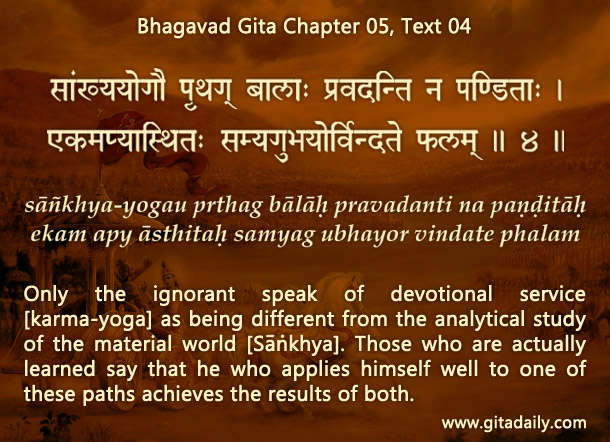The Bhagavad-gita calls humans to rise from the material mortal level of reality to the spiritual immortal level of reality. For this ascent it offers different spiritual paths known as yogas coming from the root yuj meaning ‘to connect’.
The various yogas seem at first glance drastically different: karma-yoga centers on action; jnana-yoga, on renunciation. Yet the Gita (05.04) chides as childish those who get carried away by such difference. Just as children frequently don’t see beyond externals, these neophyte seekers can’t see beyond the external dissimilarities to the essential similarity – the same destination that both intend to achieve. Both aim to raise seekers from matter to spirit, so both are auspicious, as the Gita has asserted earlier (05.02).
Such Gita verses are meant to inject a sense of urgency into tarrying neophytes. When people are caught in the throes of materialism, destined towards an unknowably long sentence of suffering in material existence, any way out of those clutches is good. For them to quibble over the relative merits of different yogas while practicing none is a self-induced spiritual catastrophe. To stop such quibbling, the Gita emphasizes the similarities among various yogas, thereby urging people to begin some yoga without delay.
Once this initial part of the rescue mission is accomplished and materialists have become yogis, the Gita goes into technical comparison of different yogas. Though all yogas raise seekers from matter to spirit, not all yogas raise people all the way from the lowest levels of material illusion to the highest levels of spiritual enlightenment. Bhakti-yoga reaches down to the lowest level (09.32) and extends up to the highest level (06.47). That’s why the same Gita that initially emphasizes the similarities of different yogas concludes (18.66) by differentiating between them, endorsing bhakti-yoga alone.



Its similar to a person standing on earth, looking at the sky and ordinarily speculating whether which of the objects – the sun, moon or some star is far than the rest, based on imperfect data available with our naked eye.
Standing at such a point on earth, its actually irrelevant to compare distances of these celestial objects which are all very far (in light years!!) away from us – almost equidistant for all our practical purposes.
Therefore, mere speculation on their distance parameter, without making actual effort to find out what is relevant for our practical use, seems to be useless.